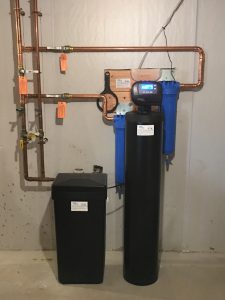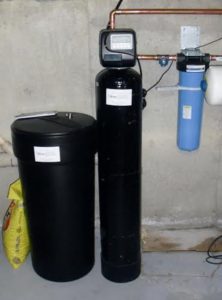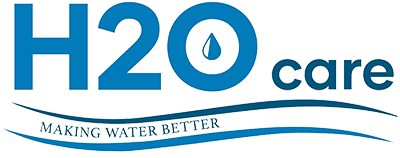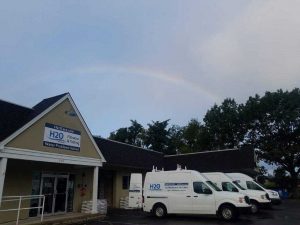
Replace Water Softener ?
Water softener replacement with a new, more efficient system may be the best option when an older one has problems that require expensive parts and labor costs. Water softeners process thousands of gallons of water per month. To ensure proper operation and to maximize the useful life of your equipment, proper maintenance will provide consistent softened or conditioned water to your home. It is possible to have interim operational problems (identified later in this report) which can be diagnosed and remedied by the homeowner. For complicated problems, contacting your water treatment service technician is your best option.

High Efficiency Water Softener
IF YOUR WATER SOFTENER ISN’T WORKING
Check to see if the softener is “on” and system has power, then:
- Check brine (salt) tank: Is there salt in the brine tank? If not, add at least a few bags to the tank. Best to have level at half to 3/4 full.
- Check power to the softener: If the unit uses electricity to run a timer, be sure it’s plugged in to a live outlet and has power. Some water conditioners use a low-voltage transformer to power the control – be sure that device is present, plugged in, and working. Also, a power failure could cause the timer to be improperly set. Re-set the day of week and time of day on the water softener timer after an electrical power failure or after the softener has been powered “off” for a time.
- Check bypass valve: You want first to see that the water softener is not on “bypass” – is household water flowing through the unit? This valve is an option and may not be installed on your unit, but there may be standard plumbing valves or globe valves that accomplish the same purpose.
- Manual regeneration cycle: Then try a manual regeneration cycle – you’ll see on most units a lever you can push on the control box to start that regeneration process. Note: your home will not be delivered conditioned or softened water while the water softener is in the regeneration cycle, therefore, its best not to use water (or use as little as possible- flushing toilets is OK, etc.) in the home until the regeneration process is complete. This is why most programmed regeneration is set for late at night when water usage is much less likely.
- Feel & test the water supply: if you can’t get a lather when bathing the system may not be sufficiently treating the water.

Replace Water Softener or Repair
OTHER POTENTIAL SYMPTOMS OF PROBLEMS
Without full diagnosis, it can be difficult to determine what is really causing the problem. This is where a service technician will be able to trouble shoot the situation and come to a determination and solution to the problem. While there are so many possible symptoms and problems, the following are a few that you may see.
- Salt consumption by the system is requiring higher than normal salt tank fill ups
- Staining on home fixtures even though the softener seems to be running properly
- Mineral discharging from the softener and into the home’s water supply
- Loss of pressure in the home’s distribution system downstream from the softener
- Hard water symptoms observed right after a regeneration cycle.


